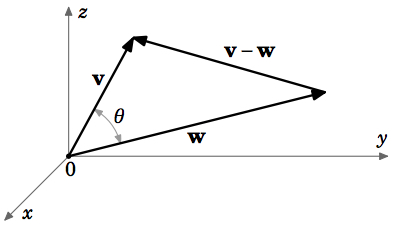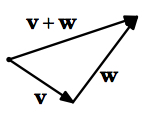1.3: Dot Product
( \newcommand{\kernel}{\mathrm{null}\,}\)
You may have noticed that while we did define multiplication of a vector by a scalar in the previous section on vector algebra, we did not define multiplication of a vector by a vector. We will now see one type of multiplication of vectors, called the dot product.
Definition 1.6: Dot Product
Let v=(v1,v2,v3) and w = (w1,w2,w3) be vectors in R3. The dot product of v and w, denoted by v⋅w, is given by:
v⋅w=v1w1+v2w2+v3w3
Similarly, for vectors v=(v1,v2) and w=(w1,w2) in R2, the dot product is:
v⋅w=v1w1+v2w2
Notice that the dot product of two vectors is a scalar, not a vector. So the associative law that holds for multiplication of numbers and for addition of vectors (see Theorem 1.5 (b),(e)), does not hold for the dot product of vectors. Why? Because for vectors u, v, w, the dot product u⋅v is a scalar, and so (u⋅v)⋅w is not defined since the left side of that dot product (the part in parentheses) is a scalar and not a vector.
For vectors v=v1i+v2j+v3k and w=w1i+w2j+w3k in component form, the dot product is still v⋅w=v1w1+v2w2+v3w3.
Also notice that we defined the dot product in an analytic way, i.e. by referencing vector coordinates. There is a geometric way of defining the dot product, which we will now develop as a consequence of the analytic definition.
Definition 1.7
The angle between two nonzero vectors with the same initial point is the smallest angle between them.
We do not define the angle between the zero vector and any other vector. Any two nonzero vectors with the same initial point have two angles between them: θ and 360∘−θ. We will always choose the smallest nonnegative angle θ between them, so that 0∘≤θ≤180∘. See Figure 1.3.1.

We can now take a more geometric view of the dot product by establishing a relationship between the dot product of two vectors and the angle between them.
Theorem 1.6
Let v, w be nonzero vectors, and let θ be the angle between them. Then
cosθ=v⋅w‖v‖‖w‖
Proof
We will prove the theorem for vectors in R3 (the proof for R2 is similar). Let v=(v1,v2,v3) and w=(w1,w2,w3). By the Law of Cosines (see Figure 1.3.2), we have
‖v−w‖2=‖v‖2+‖w‖2−2‖v‖‖w‖cosθ
(note that Equation ???) holds even for the "degenerate'' cases θ=0∘ and 180∘).

Since v−w=(v1−w1,v2−w2,v3−w3), expanding ‖v−w‖2 in Equation ??? gives
‖v‖2+‖w‖2−2‖v‖‖w‖cosθ=(v1−w1)2+(v2−w2)2+(v3−w3)2=(v21−2v1w1+w21)+(v22−2v2w2+w22)+(v23−2v3w3+w23)=(v21+v22+v23)+(w21+w22+w23)−2(v1w1+v2w2+v3w3)=‖v‖2+‖w‖2−2(v⋅w), so−2‖v‖‖w‖cosθ=−2(v⋅w), so since v≠0 and w≠0 thencosθ=v⋅w‖v‖‖w‖, since‖v‖>0 and ‖w‖>0.
Example 1.5
Find the angle θ between the vectors v=(2,1,−1) and w=(3,−4,1).
Solution
Since v⋅w=(2)(3)+(1)(−4)+(−1)(1)=1, ‖v‖=√6, and ‖w‖=√26, then
cosθ=v⋅w‖v‖‖w‖=1√6√26=12√39≈0.08 ⟹ θ=85.41∘.
Two nonzero vectors are perpendicular if the angle between them is 90∘. Since cos90∘=0, we have the following important corollary to Theorem 1.6:
Corollary 1.7
Two nonzero vectors v and w are perpendicular if and only if v⋅w=0.
We will write v⊥w to indicate that v and w are perpendicular.
Since cosθ>0 for 0∘≤θ<90∘ and cosθ<0 for 90∘<θ≤180∘, we also have:
Corollary 1.8
If θ is the angle between nonzero vectors v and w, then
v⋅w is ={>0,for 0∘≤θ<90∘0,for θ=90∘<0,for 90∘<θ≤180∘
By Corollary 1.8, the dot product can be thought of as a way of telling if the angle between two vectors is acute, obtuse, or a right angle, depending on whether the dot product is positive, negative, or zero, respectively. See Figure 1.3.3.

Example 1.6
Are the vectors v=(−1,5,−2) and w=(3,1,1) perpendicular?
Solution
Yes, v⊥w since v⋅w=(−1)(3)+(5)(1)+(−2)(1)=0.
The following theorem summarizes the basic properties of the dot product.
Theorem 1.9: Basic Properties of the Dot Product
For any vectors u,v,w, and scalar k, we have
- v⋅w=w⋅v Commutative Law
- (kv)⋅w=v⋅(kw)=k(v⋅w) Associative Law
- v⋅0=0=0⋅v
- u⋅(v+w)=u⋅v+u⋅w Distributive Law
- (u+v)⋅w=u⋅w+v⋅w Distributive Law
- |v⋅w|≤‖v‖‖w‖ Cauchy-Schwarz Inequality
Proof
The proofs of parts (a)-(e) are straightforward applications of the definition of the dot product, and are left to the reader as exercises. We will prove part (f).
(f) If either v=0 or w=0, then v⋅w=0 by part (c), and so the inequality holds trivially. So assume that v and w are nonzero vectors. Then by Theorem 1.6,
v⋅w=cosθ‖v‖‖w‖, so|v⋅w|=|cosθ|‖v‖‖w‖, so|v⋅w|≤‖v‖‖w‖ since |cosθ|≤1.
Using Theorem 1.9, we see that if u⋅v=0 and u⋅w=0, then u⋅(kv+lw)=k(u⋅v)+l(u⋅w)=k(0)+l(0)=0 for all scalars k,l. Thus, we have the following fact:
If u⊥v and u⊥w, then u⊥(kv+lw) for all scalars k,l.
For vectors v and w, the collection of all scalar combinations kv+lw is called the span of v and w. If nonzero vectors v and w are parallel, then their span is a line; if they are not parallel, then their span is a plane. So what we showed above is that a vector which is perpendicular to two other vectors is also perpendicular to their span.
The dot product can be used to derive properties of the magnitudes of vectors, the most important of which is the Triangle Inequality, as given in the following theorem:
Theorem 1.10: Vector Magnitude Limitations
For any vectors v,w, we have
- ‖v‖2=v⋅v
- ‖v+w‖≤‖v‖+‖w‖ Triangle Inequality
- ‖v−w‖≥‖v‖−‖w‖
Proof:
(a) Left as an exercise for the reader.
(b) By part (a) and Theorem 1.9, we have
‖v+w‖2=(v+w)⋅(v+w)=v⋅v+v⋅w+w⋅v+w⋅w=‖v‖2+2(v⋅w)+‖w‖2, so since a≤|a| for any real number a, we have≤‖v‖2+2|v⋅w|+‖w‖2, so by Theorem 1.9(f) we have≤‖v‖2+2‖v‖‖w‖+‖w‖2=(‖v‖+‖w‖)2and so‖v+w‖≤‖v‖+‖w‖after taking square roots of both sides, which proves (b).
(c) Since v=w+(v−w), then ‖v‖=‖w+(v−w)‖≤‖w‖+‖v−w‖ by the Triangle Inequality, so subtracting ‖w‖ from both sides gives ‖v‖−‖w‖≤‖v−w‖.
The Triangle Inequality gets its name from the fact that in any triangle, no one side is longer than the sum of the lengths of the other two sides (see Figure 1.3.4). Another way of saying this is with the familiar statement "the shortest distance between two points is a straight line.''




